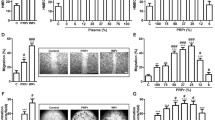Summary
Purpose: Biological agents like human serum or autologous platelets have recently been employed as adjuvants for macular hole surgery. However, the role of these agents on the retinal cellular level remains unclear. In the present study, we investigated the effect of human platelets, serum and PDGF on RPE migration and proliferation in cell culture.
Methods: Human RPE were cultured in DMEM + 2 % FCS and experiments performed at passages 2–4. Human platelet concentrate (PC) and serum (HS) were isolated from blood of patients previewed for macular hole surgery; human PDGF-BB was from Pepro Tech. PC and HS at protein concentrations ranging from 50–1000 μg/ml and PDGF at 1 and 10 ng/ml were added to 5000 cells/well in the proliferation assay and to a confluent RPE monolayer on which a central mechanical “wound” (5 mm diameter) was made. Incubation times ranged from 1 h to 5 days. Cell numbers at D 5 were indirectly determined by protein measurements. In the wound model, the cells inside the wound area were counted and results compared to the control cultures that received no supplements.
Results: Cell proliferation was significantly stimulated over controls by all concentrations of PC, HS and PDGF with any incubation time. Compared to PC and PDGF, HS revealed less proliferation after 1–6 h of incubation; there was no significant difference from PC with other incubation times. In the wound model, both PC and PDGF significantly increased the number of cells migrating into the denuded area after 1 h incubation with the culture medium; longer incubation times had no further effect compared to controls.
Conclusion: The present study is the first to demonstrate that human platelet concentrate induces proliferation and migration of RPE cells in vitro. However, PDGF, a growth factor which is abundantly present in platelets, was found to be at least equally effective. We assume that the majority of the mitogenic effect of platelet concentrate is due to PDGF.
Zusammenfassung
Hintergrund: Der Effekt des Einsatzes von autologem Thrombozytenkonzentrat (TK) in der Makulachirurgie wurde bisher nur durch klinische Verlaufsbeurteilungen (postoperativer Visus) eruiert. Aufgrund der bekannten Spontanheilungen von Makulalöchern steht der Nachweis einer Wirksamkeit dieser Substanz auf zellulärer Ebene bisher noch aus. In der vorliegenden Studie untersuchten wir den Wundheilungseffekt von TK auf humane RPE-Zellen im Vergleich zu humanem Serum (HS) und dem Wachstumsfaktor PDGF.
Material und Methode: Aus Spenderbulbi isolierte RPE-Zellen wurden in DMEM mit 2 % x (FCS) gezüchtet. Autologes TK und HS wurden in Proteinkonzentrationen von 50–1000 μg/ml zum Kulturmedium gegeben (für PDGF: 1 bzw. 10 ng/ml) und für 1 Stunde bis 5 Tage inkubiert. Kontrollkulturen erhielten keinen Zusatz. Nach 5 Tagen erfolgte der Nachweis einer Proliferationsstimulation mittels Zellzählung und Proteinbestimmung. Parallel wurde ein möglicher wundheilungsstimulierender Effekt der für eine Stunde inkubierten Substanzen 5 Tage nach Läsion konfluenter Kulturen über automatisierte Bildanalyse der neu bewachsenen Wundfläche gemessen.
Ergebnisse: Im Vergleich zu den Kontrollen führten alle zugesetzten Agentien zu einer signifikanten Proliferationsstimulation mit zunehmender Inkubationszeit und ansteigenden Konzentrationen. TK und PDGF zeigten lediglich bei kürzeren Inkubationszeiten (1–6 h) höhere Proliferationsraten als HS. Auch im Wundmodell konnte durch TK- und PDGF-Zusatz eine im Vergleich zu HS raschere Migration der Zellen gefunden werden.
Schlußfolgerung: Erstmalig wird in dieser Studie ein proliferations- und migrationsfördernder Effekt von autologem TK auf humane RPE-Zellen nachgewiesen. Die Wirksamkeit von Thrombozytenkonzentrat zeigt sich bei identischen Konzentrationen der von humanem Serum überlegen; ein vergleichbarer Effekt auf zelluläres Wachstum und Wundheilung läßt sich jedoch auch durch die isolierte Zugabe des Wachstumsfaktors PDGF erzielen. Der wundheilungsfördernde Effekt von TK ist somit möglicherweise durch das in Thrombozyten reichlich vorhandene PDGF bedingt.
Similar content being viewed by others
Author information
Authors and Affiliations
Rights and permissions
About this article
Cite this article
Velhagen, KH., Druegg, A. & Rieck, P. Effect of human platelet concentrate, serum and PDGF on RPE cell proliferation and wound healing in vitro. Ophthalmologe 96, 77–81 (1999). https://doi.org/10.1007/s003470050378
Published:
Issue Date:
DOI: https://doi.org/10.1007/s003470050378




